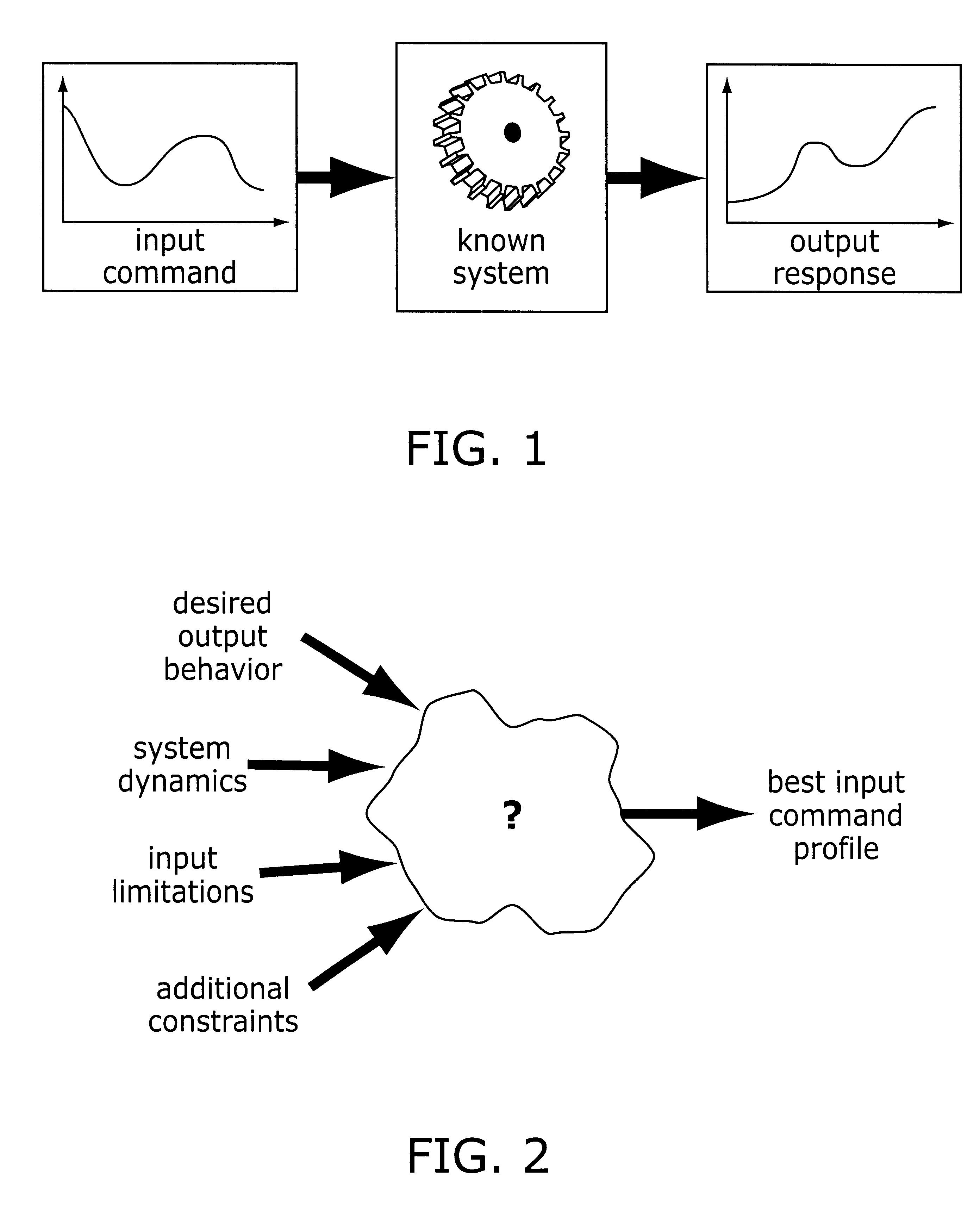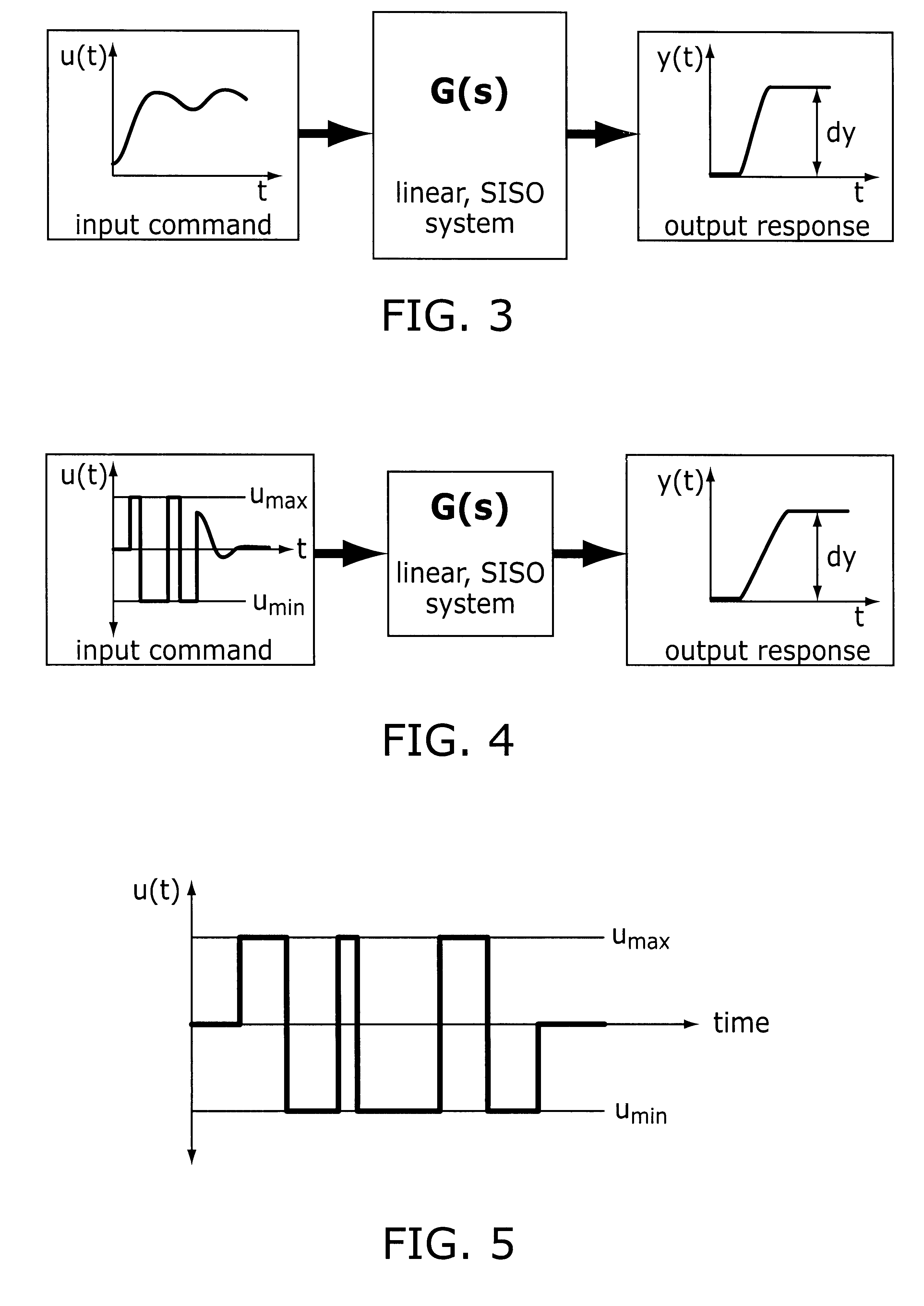In some situations, however, this is not enough.
Many systems, however, do not tolerate these types of changes.
An engineer at a hydroelectric
plant, for example, would be foolhardy to consider building a new dam to better control the
power output.
The problem facing designers who wish to improve the performance of their systems, which can be called "the feedforward control problem", addresses the question of how to select the input command for a given system that produces the most desirable output response.
As an unfortunate side-effect of these performance enhancements, undesirable
machine dynamics often become the primary barrier to further performance improvements.
However, due to design limitations,
actuator capacity must often be restricted.
In this regard, in addition to accounting for desired output behavior,
system dynamics, and input limitations, many systems may be sensitive to other performance variables.
Other systems may have additional requirements such as limitations on internal loading or energy efficiency.
This
problem statement, however, is far too general to lend insight into a solution approach.
Third, it will be assumed that the goal of the problem is to transition the system output rapidly from one
rest state to another rest state.
With this long history of research, it is difficult to know where to begin to describe the state of the art.
In approaching this task, design engineers typically face a variety of design tradeoffs that influence the construction of the hardware and the performance of the
machine.
Primarily due to space, weight, and power constraints, this is not always possible.
When design considerations do not allow for this kind of hardware augmentation, the
design engineer must turn to feedback approaches to eliminate undesirable system dynamic behavior.
However, in some systems, such as ones where sensor feedback is unavailable, high-
performance control is not an option.
While closed-
loop control techniques are used for minimizing error in the face of disturbances, they cannot always be optimized for the task at hand.
The time-
optimal control problem, as stated above, is concerned with finding the fastest possible ways to move systems from one state to another.
Due in part to the complexity of these initial approaches and since energy-based control methods promised greener pastures, work in this area was largely abandoned.
Unfortunately, applying these tools to the task of deriving commands for a given system is not immediately straightforward.
A number of techniques have been proposed for doing this, but all are numerically intensive and largely too unreliable to be applied to a wide class of systems.
Although solution techniques are numerically complex and unreliable, many researchers have set these processes to the task of deriving time-optimal commands for nonlinear systems.
First, largely due to the complexity of numerical and iterative approaches for solving this problem, much of the recent work in this area has focused on making statements about the general nature of optimal commands in order to reduce the size of the solution space.
Research results revealed that, although
input shaping is inherently a digital filtering technique, conventional digital filters, since they are not intended for mechanical systems, cannot equal the performance of input shapers.
Unfortunately, due the nature of the constraints in Pontryagin's principle,
iterative search routines can be numerically intensive and solutions can be elusive.
Largely due to this inherent complexity, these types of solution approaches have seen limited application on complex systems.
What is yet unavailable, however, is a simple approach that can be applied with generality to virtually all types of linear systems.
As outlined above, the time-
optimal control problem places a strict set of constraints on system response to a time-optimal command profile.
In general, finding a D(s) to exactly cancel G(s) is not often possible.
Additionally, since the equations are algebraic and implemented as
vector operations, computational requirements are small.
For systems with repeated roots, the dynamics cancellation equations prove to be somewhat more complex to express.
Additionally since all of the calculations in this code are algebraic and can be expressed largely as
vector operations, the computational requirements of this code are small.
The second boundary condition, which requires that the system output change by the desired amount, dy, is more complicated to express.
This numerically intensive procedure would likely result in undesirably long solution times.
Since this type of command will eventually exceed the system
actuator limits, there is no time-optimal command that will satisfy the problem constraints.
However, it is difficult to derive a general
analytic expression for the solution of equation 3.23 using this approach.
In these situations, the integral in equation 3.35 will not converge as t goes to .infin.. However, as will be discussed later herein, creating time-optimal commands with undamped or unstable oscillation is bad design practice and should not be implemented on a real system.
In order to implement this equation, all that is required is to take the limit of N(s) / D(s), which is trivial given the system
transfer function, and to integrate u(t) from 0 to .infin. rbp times. To perform this integration, a numerical integration routine could be performed during the problem optimization, but this is very numerically intensive.
However in most cases, the constraint equations are too complex to succumb to analytic solution and must be solved using an optimization process.
Since optimization processes can be vulnerable to suboptimal local minima, this solution approach cannot guarantee that the time-optimal command will always be found.
Additionally, in some systems, such as ones with a high degree of dynamic uncertainty, the presence of a
tail in the input command might be undesirable.
It is known from the dynamics cancellation constraint that incorporating any uncancelled dynamics into the command profile will either increase the time-length of the command or cause unwanted system
residual vibration.
In general, analytic solutions are only available for very simple systems.
Since the constraint equations for this system are too complex to be solved analytically, a numerical optimization routine must be used.
Since the flexibility in this system does not dominate the overall dynamic response, the response of the system to the time-optimal input shaper shows no improvement over the pulse command.
However, in other systems that do not require such
rapid response, time-optimal command profiles may be undesirable.
For example, in systems with a large degree of dynamic uncertainty, time-optimal commands may excite unwanted
residual vibration due to discrepancies between the
system model and actual behavior.
Additionally, because of their bang-bang nature, time-optimal commands may result in excessive fuel usage or heavy operating loads in certain classes of systems.
Unfortunately, due to such factors as time-varying dynamics and nonlinear behavior, discrepancies always exist between the model and the actual system.
As a result of these discrepancies, time-optimal commands designed using
model parameters can sometimes result in unacceptable performance upon implementation.
A time-optimal command that is not robust to uncertain
system dynamics will often deliver unacceptable performance when the system behaves differently than the model predicts.
However, when faced with model discrepancies, this time-optimal command will always result in a nonzero amount of residual response around the desired system output value.
When a time-optimal command that was designed for the
system model is applied to the actual system, these discrepancies can result in output behavior with excessive residual response.
Unfortunately, these same insights cannot be extended to system zeros.
As may be obvious, this strategy only introduces extra dynamics into the system that will increase the amount of residual response.
Not surprisingly, the insensitivity curve for the system zero shows little improvement.
In many applications, it is undesirable to have a
tail that drives a system after the output has reached its desired final value.
Furthermore, if the frequencies of the system zeros are not known exactly, this
tail will cause problematic residual response in the system output.
Similarly, in some systems that require gentle yet
fast motion, deflection limiting constraints can be incorporated to limit the internal loads and resulting machine deflection during operation.
The reason for this is that, when an optimization routine has too few switches in a candidate command, there will be no viable solution that satisfies the problem constraints.
In particular, the approach outlined in [114] was used to create non-time-optimal bang-bang commands that satisfied the identical problem constraints.
For many systems, this approach worked very well, however, for some more complex systems, different initial guesses were required.
If not, then the conditions in Pontryagin's
Minimum Principle do not guarantee that a time-optimal solution will exist or be unique.
However, since we know that this function must be zero at the locations of the command switch times, the proposed optimal command will only be optimal if
If no initial costate vectors exist that satisfy this set of equations, then the proposed command is not time-optimal.
The usefulness of this approach does not end there, however, since this approach can also be applied to robust, time-optimal commands and commands with tail-length constraints.
For systems that are more complicated than these, finding time-optimal solutions can be tedious and unreliable.
However, since time-optimal commands typically have little energy at higher system
modes, commands designed for fewer than five system
modes often prove to be more than adequate for delivering the desired performance upon implementation.
As the results in FIG. 51 illustrate, when a step command is sent to the
gimbal servo to effect the desired change in
gimbal angle, substantial lightly damped vibration is excited in the MACE structure which corrupts the pointing accuracy of the
gimbal.
As illustrated in FIG. 52, these commands can be effective at reducing problematic vibration but typically introduce a substantial
lag in the system response.
Unfortunately, the price that is paid for this rapid system response is the undesirably high levels of
residual vibration.
Since this residual vibration is not present in the simulated response for the 156-
state model, it can largely be attributed to poor command insensitivity to model inaccuracies.
However, the increased
response time required to obtain this measure of robustness undercuts the value of this command solution.
Unfortunately, due to poor command robustness in the presence of many lightly damped system
modes, these time-optimal commands often excited undesirable levels of residual vibration in the system response.
 Login to View More
Login to View More  Login to View More
Login to View More 


